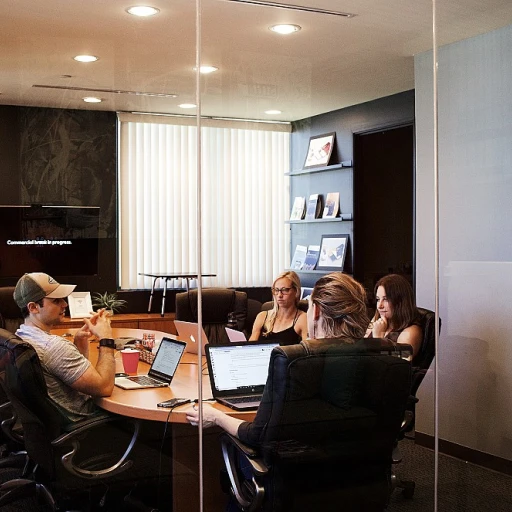
Understanding the Need for Office Relocation
Recognizing the Reasons for Office Moves
Planning an office move can seem like a daunting task, but many businesses often find it necessary for various reasons. Whether it's due to outgrowing your current office space or wanting to be closer to your clients, an office relocation can open new doors for growth and efficiency. Consider an office that's been experiencing rapid growth. Employees are practically elbow-to-elbow, conference rooms are hard to book, and storage areas are bursting at the seams with extra furniture and office equipment. This is a clear sign that it's time to consider office movers who can offer moving services and a new commercial space that better supports the company’s needs. Sometimes, a move is about enhancing the office environment to boost employee morale and productivity. Businesses seek to create a workspace that not only accommodates their team comfortably but also inspires creativity and collaboration. Commercial movers can assist in transitioning to an office space that reflects your company culture and values. Let's not forget the financial aspect. Relocating can also be financially motivated. Companies might find a new facility with better commercial moving rates or lower monthly expenses, offering a chance to redirect savings towards growth opportunities. In any case, recognizing these needs early paves the way for a smooth transition and prepares everyone involved for what's ahead. Understanding the core reasons behind your decision to engage a licensed and insured moving company provides a solid foundation for the planning and coordination phase. For ideas on improving your new workspace environment post-move, consider strategies that focus on boosting cleanliness and hygiene in the office. A fresh start in a new location offers a wonderful opportunity to instill better practices.Evaluating Potential Moving Vendors
Finding the Right Moving Partners
Finding reliable moving partners is a bit like choosing the best teammates for a crucial match. You want those who are not just competent but also in tune with your business goals and timeline. The market is filled with moving companies, each bubbling with promises of impeccable service, but remember, not all movers are created equal. Let's start by drilling down into the credentials. Always choose a licensed insured moving service—someone who gives you peace of mind that your office's precious cargo is in safe hands. Seek out companies with a strong track record of office moves, particularly in the commercial moving scene. Experience in handling office equipment and office furniture is a must-have. After all, you want office movers who have done the grind and know the ropes. Past customer reviews and testimonials are gold. While digging through the testimonials, see if there are patterns or recurring themes of consistent praise—or red flags. North American van lines and other big names often have a rich history you can rely on, but don't discount local champions who can offer personalized services. Another piece of the puzzle is to ensure your chosen moving company can meet your specific needs. Assess if they offer full service, including packing, storage solutions, and nifty relocation services. These can be real game-changers, ensuring a smoother transition without you lifting a finger. Choosing the right mover is not just about today; it's about safeguarding tomorrow. For a deeper dive, consider reading our guide on efficient office supply delivery services to discover more insights tailored for UK businesses (https://www.magic-office.co.uk/blog/efficient-office-supply-delivery-services-for-uk-businesses). Remember, the right partners will not only make your move hassle-free but can also become trusted allies for future office needs.Planning and Coordination
Organise Your Office Move
When tackling an office move, timing and organizing can make or break the transition. Planning ahead is not just a good idea, it's essential. Start by creating a checklist of tasks and deadlines. Whether it's hiring a moving company for their services or arranging storage for office equipment, jot it down. A detailed list keeps everyone on track and ensures no important tasks fall through the cracks. Aligning with a reliable moving company can provide all aspects of relocation, from packing services to quick transport of office furniture. One aspect often underestimated is the value of commercial movers. They don’t just provide packing and van lines; they're adept at handling office items, including sensitive equipment and hefty furniture. Think carefully about timing. Choose a moving date that least disrupts business. Schedule the move during off-peak business hours, like after-hours or weekends, ensuring minimal disruption. You'll also need to coordinate storage solutions, especially if your new office space is smaller. Discuss with your moving company their storage options to safeguard office equipment not immediately needed. Finally, involve your employees in the process. Encouraging them to pack their own workspaces can speed up the process, and makes them feel part of the journey. Most importantly, always have open communication channels to keep them informed. For more useful insights on efficient coordination with your service providers, check out this blog post.Ensuring Minimal Downtime
Reducing Office Downtime During Moves
Smooth sailing in your office move requires striking the perfect balance between relocation and continuous business operations. When relocating, time is of the essence. Any disruption can be a blow to productivity, but with a strategic approach, you can keep the impact to a minimum. One way to minimise downtime is through careful selection of office movers and moving services. Opt for companies that provide full service solutions, which include packing, furniture relocation, and office equipment handling. A moving company that ensures a seamless transition between spaces will help keep everything on course. Leading commercial movers often offer storage solutions during moves. If your new office space isn't quite ready yet or you need a bit of extra time, this service can be a lifesaver. It helps prevent the chaos of unpacked items crowding your workspace, keeping things tidy and professional. Focusing on essentials is another crucial strategy. Prioritise the relocation of critical office equipment and items which are necessary for day-to-day operations. Some moving companies, particularly those with experience in long-distance moves like North American Van Lines, understand the importance of a well-timed rollout of essential gear. Consider scheduling the move during off-peak hours. Whether it's an overnight operation or a weekend relocation, finding a time slot that won't interfere with regular business hours is an excellent way of staying efficient. Your selected moving service will know the importance of hitting these narrow windows. Lastly, stay in touch with your office movers throughout the process. They’re your eyes and ears on the ground, so maintaining good communication helps tackle any unexpected hiccups that might arise. Communicate your timeline clearly, emphasize your priorities, and keep everyone in the loop.Managing Employee Expectations
Communicating Change and Building Support
Moving an office can stir emotions and create uncertainty, so it's essential to communicate openly with your team. A successful office move hinges on how well employees are prepared and supported. You want everyone feeling informed, involved, and excited about the new chapter. Let’s start with the office movers. You’ve taken great care selecting a moving company that understands business relocations. This choice not only affects logistics but also reassures your team about the smooth transition. Think of the movers as partners, bringing their expertise in handling items like office furniture and equipment, ensuring they're in safe hands. Inform your employees about the moving services you've arranged, from packing to storage solutions, reinforcing the trust in the process. The next step is to outline the timeline. You’ll want your employees clear on the when's and where's to avoid any surprises. Communicate the move dates and whether it's a long distance or local transition. Is there a temporary office space or storage during the move? Keeping everyone in the loop helps lessen anxiety and boosts morale. Incorporate employee feedback whenever possible. Engaging staff in planning can surface useful insights and fosters buy-in. Employees often have the best perspective on what they need for day-to-day operations, so their input is invaluable. For instance, feedback on office space layout or equipment placement can simplify aspects of the office relocation. An office move can impact routines, workloads, and stress levels. Offering support through these changes – whether it’s flexibility in work patterns or assistance in setting up new office equipment – can smooth the transition. Highlighting the benefits of the move, like improved office infrastructure or better location, can also help sway opinions positively. Lastly, don't forget to celebrate the milestone. A gathering post-move not only acknowledges the effort everyone put in but also gives a sense of achievement. It’s a chance for everyone to reconnect and settle into their new environment, ready to take on business goals with fresh vigor. Taking these steps helps manage and align employee expectations, turning a potentially stressful move into a positive, team-building experience.Post-Move Evaluation and Feedback
Reflection and Employee Feedback
Change can be tough, right? This couldn't be truer for an office moving experience. Let’s chat about how the dust has settled after the office movers have packed their gear and left. So, what happens next? The journey doesn’t just end with the relocation itself. We need to talk about reflecting on the experience and gathering feedback from employees.
First off, give everyone a breather to settle in. It’s important to allow time for employees to get used to the new office space and set up their new office equipment. Once folks are ready, hold a casual meeting or send out a survey. This will act as a productive format to gain insights into what worked well and what didn’t throughout the office move process.
Pay attention to feedback regarding the moving services. Did the moving company fulfill their promises with timely and effective services? Understanding aspects like the performance of North American van lines or other commercial movers helps in making informed decisions for future moves.
Office Space Satisfaction
Does the new office layout fit the bill for your business needs? Take stock of how office storage solutions and office furniture are being utilized. If something’s not right, nip it in the bud and perhaps explore additional relocation services for adjustments.
An employee’s ability to comfortably work with their office equipment is paramount. Use this feedback to refine the office environment, ensuring a happy and productive team.
Feedback isn’t just for tweaking the physical space. Use it to evaluate the office movers’ service levels as well. If they added value, it might be worthwhile to maintain the relationship with that particular moving company or consider making them your go-to experts for future office moves.
Continuous Improvement
So, how do we move forward? Take a cue from lessons learned during the office relocation, such as any long-distance or last-minute challenges faced. These insights prepare you for future shifts and refining any strategies that need reworking.
Remember, a successful office move isn’t just about shifting items around. You want to ensure that the transition keeps commercial productivity and employee satisfaction high. As with any moving company, there’s always room for growth, and there’s always the best out there who are licensed insured and offer stellar full-service support.
The transition period after relocation is all part of the larger picture. Keep the dialogue open, collect feedback, and continue building a workspace that everyone is glad to call their office home.













